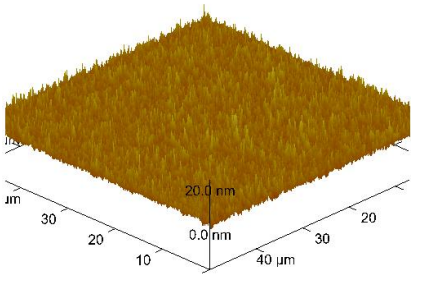Oxygen-free silicon surfaces are desired for high quality silicon epitaxy.Conventionally, to achieve oxygen-free and carbon-free surfaces, it is necessary toperform in-situ cleaning steps with temperatures in the range of 760℃ to 850℃ or higherto reduce oxygen levels to below the secondary ion mass spectrometry (SIMS) resolutionlimit (1)(2). Cleaning temperatures less than 700℃ are desired, however, to minimize thediffusion of dopants in existing structures, such as would occur when using epitaxy forraised source/drain applications. In this work, we demonstrate the use of chlorine etchingat 575℃ to produce oxygen-free surfaces and substantially reduce interface phosphorusand carbon levels before epitaxy.
Thermal etching of silicon in-situ in epitaxial reactors is typically done usinghydrogen chloride (HCl) in a hydrogen ambient. However, the etch rates using thisprocess are very low below 800℃. For temperatures less than 750℃, the etch rates withHCl have been observed to be less than 1nm/min (3). Previously attempts made to useusing chlorine instead of hydrogen chloride to etch silicon in a hydrogen ambient (4). Itwas observed that the etch rate was still negligible below 750℃. The authors believedthat hydrogen was reacting with the chlorine to form HCl.
In our experiments we use a nitrogen ambient instead of a hydrogen ambient for thethermal etching of silicon with chlorine. A partial pressure of 6 torr of nitrogen and 30mtorr of chlorine was used in our experiments. The work was done in a lamp-heatedcold-wall single-wafer rapid thermal chemical vapor deposition (RTCVD) reactor. Etchrates of 11nm/min, 5nm/min, and 1nm/min were achieved at 575℃, 550℃, and 525℃respectively, based on step height measurements. For such measurements, the unetchedareas were masked with silicon dioxide. A comparison of etch rates based on chlorineand HCl vs. inverse temperature is shown in Figure 1.
Chlorine etch rates versus chlorine flow rates are plotted in figure 2. The etch rate isstill increasing with the flow rate, indicating that even faster etch rates may still beachievable. Etch rates were also measured with our system using chlorine in a hydrogenambient. At high temperatures 900℃ and 1000℃, the silicon etch rate was 35nm/minand 220nm/min respectively. However, for temperatures below 700℃ the etch rates werenegligible, consistent with the earlier work.
The effectiveness of the chlorine etching for cleaning a silicon surface prior toepitaxy was examined. SIMS was done to compare the interface impurity concentrationafter silicon epitaxy that had no in-situ clean step with that after epitaxy that had a 575℃chlorine etch step. Prior to silicon growth in both steps, the sample was cleaned with aconventional ex-situ wet clean of H2SO4/H2O2 and a dilute HF dip (5). Silicon wasgrown in this experiment at 700oC at 6 torr chamber pressure using dichlorosilane (DCS)as the silicon source. A 2.5-nm boron doping marker was used to indicate the start ofsilicon epitaxy in both cases. Both experiments were performed on a single wafer so datacould be obtained with a single SIMS measurement. After the first wet cleaning thesample was loaded into the reactor in a hydrogen environment. The temperature wasraised to 700℃ and approximately 150 nm of silicon was grown, without any cleaningsteps such as a high temperature hydrogen bake. The wafer was then taken out of thereactor and exposed to air for 12 hours. Now the sample was chemically cleaned again asdescribed earlier. After loading, 20 nm of silicon was etched back using chlorine innitrogen ambient at 575℃ prior to epitaxy. After etching, the ambient was switched tohydrogen, the temperature was then raised to 700℃ and 50 nm of silicon was grown.From the SIMS shown in Figure 4, we observed an interfacial spike in both oxygen andcarbon levels for the growth with no cleaning step and no interfacial oxygen above theSIMS background was visible in the case of the chlorine etching. The interfacial spike incarbon level is also significantly smaller in the latter case.

Fig1
Experiments were done to test the ability of chlorine surface etching steps to removeother surface impurities, specifically phosphorus. A thermal desorption step at 800℃, achlorine surface cleaning step by etching at 575℃, and no in-situ cleaning werecompared. Silicon was grown in this experiment at 700℃ at 6 torr chamber pressureusing dichlorosilane (DCS) as the silicon source in hydrogen ambient. The growth washalted and a 0.5 sccm phosphine dose was injected into the chamber with 3 slpmhydrogen flow at a temperature of 700℃ at 6 torr chamber pressure for 5 minutes to coatthe surface with phosphorus.
For the first cleaning step, we attempted to remove the phosphorus from the surfaceby etching with chlorine at 575℃. Silicon was then grown and a thin SiGe layer was thengrown to reduce the surface concentration of phosphorus prior to the next phosphine dose, followed by a second phosphine exposure. After the second phosphine dose, weattempted to remove the phosphorus via desorption by heating the surface to 800℃ for 10minutes. Silicon was then grown followed by a thin SiGe layer to reduce the surfaceconcentration of phosphorus prior to the next phosphine dose, followed by a finalphosphine exposure. After the last phosphine dose, no cleaning step was performed andmore silicon was grown. At no time was the chamber opened or the sample removedduring this experiment. A SIMS measurement of dopants and impurities vs. depth isshown in Figure 5.